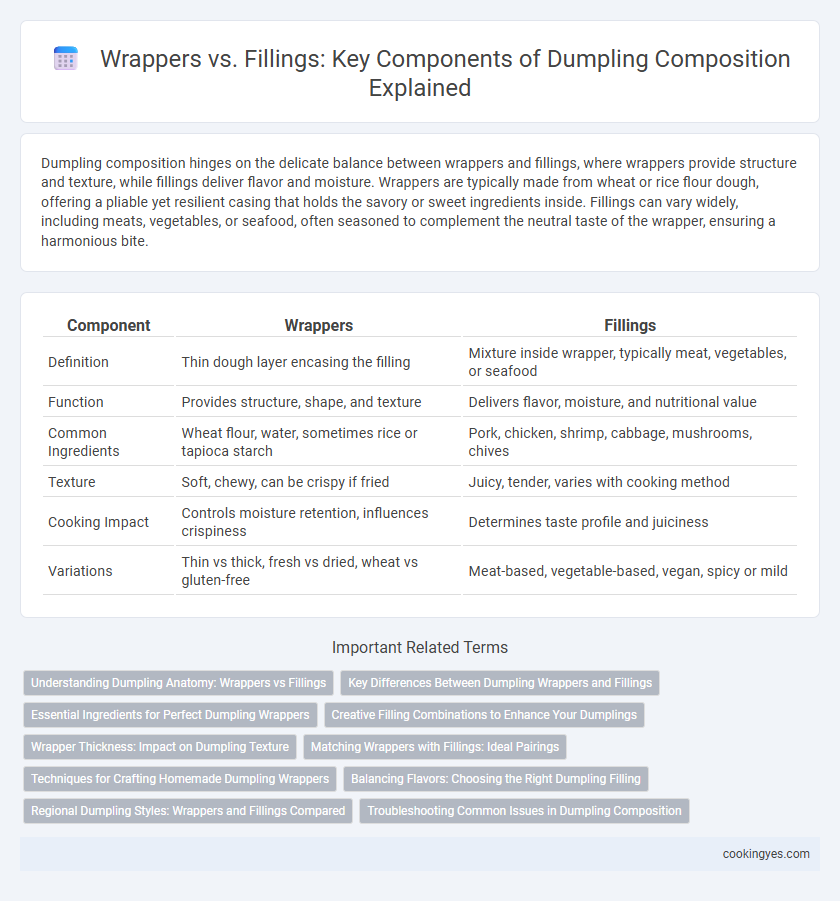Dumpling composition hinges on the delicate balance between wrappers and fillings, where wrappers provide structure and texture, while fillings deliver flavor and moisture. Wrappers are typically made from wheat or rice flour dough, offering a pliable yet resilient casing that holds the savory or sweet ingredients inside. Fillings can vary widely, including meats, vegetables, or seafood, often seasoned to complement the neutral taste of the wrapper, ensuring a harmonious bite.
Table of Comparison
| Component | Wrappers | Fillings |
|---|---|---|
| Definition | Thin dough layer encasing the filling | Mixture inside wrapper, typically meat, vegetables, or seafood |
| Function | Provides structure, shape, and texture | Delivers flavor, moisture, and nutritional value |
| Common Ingredients | Wheat flour, water, sometimes rice or tapioca starch | Pork, chicken, shrimp, cabbage, mushrooms, chives |
| Texture | Soft, chewy, can be crispy if fried | Juicy, tender, varies with cooking method |
| Cooking Impact | Controls moisture retention, influences crispiness | Determines taste profile and juiciness |
| Variations | Thin vs thick, fresh vs dried, wheat vs gluten-free | Meat-based, vegetable-based, vegan, spicy or mild |
Understanding Dumpling Anatomy: Wrappers vs Fillings
Dumpling anatomy consists of two essential components: the wrapper and the filling, each contributing unique textures and flavors. Wrappers are thin dough sheets made from wheat, rice, or tapioca flour, providing the structural integrity and chewiness necessary for holding the filling. Fillings vary widely, including minced meats, vegetables, seafood, or tofu, often seasoned with herbs and spices to create a harmonious balance that complements the neutral wrapper.
Key Differences Between Dumpling Wrappers and Fillings
Dumpling wrappers serve as the thin, pliable outer layer made primarily from wheat or rice flour, designed to hold the fillings securely while providing a chewy texture. Fillings vary widely, including combinations of meat, vegetables, or seafood, and are seasoned to deliver the core flavors and moisture inside the wrapper. The key difference lies in function: wrappers provide structure and texture, whereas fillings contribute the dumpling's taste and nutritional value.
Essential Ingredients for Perfect Dumpling Wrappers
Essential ingredients for perfect dumpling wrappers include high-protein wheat flour, water, and sometimes a pinch of salt to enhance dough elasticity and texture. Proper hydration ratio and kneading technique ensure the dough is smooth and pliable, enabling easy folding and sealing without tearing. Using cold water slows gluten development, resulting in tender, chewy wrappers that complement a variety of fillings.
Creative Filling Combinations to Enhance Your Dumplings
Creative filling combinations for dumplings elevate their flavor profile, blending ingredients like spicy Szechuan peppercorn chicken with roasted garlic and shiitake mushrooms or a fusion of sweet potato, goat cheese, and caramelized onions. Choosing complementary textures such as crunchy water chestnuts paired with tender pork enhances the mouthfeel, while incorporating fresh herbs like cilantro or mint adds aromatic complexity. Experimenting with global influences, such as Thai-inspired lemongrass and shrimp or Mediterranean spinach and feta, transforms traditional dumplings into unforgettable culinary delights.
Wrapper Thickness: Impact on Dumpling Texture
Wrapper thickness significantly influences dumpling texture, with thinner wrappers delivering a delicate, tender bite that highlights the filling's flavor, while thicker wrappers offer a chewier, heartier mouthfeel that can balance robust or dense fillings. Optimal wrapper thickness varies by dumpling style; for example, Chinese jiaozi feature medium-thin wrappers for a harmonious texture, whereas thicker wrappers are common in Japanese gyoza to withstand pan-frying and maintain moisture. Controlling dough hydration and rolling technique ensures consistent thickness, directly affecting the structural integrity and overall eating experience of the dumpling.
Matching Wrappers with Fillings: Ideal Pairings
Thin, delicate wrappers made from wheat flour best complement light fillings like shrimp and vegetables, allowing the flavors to shine without overwhelming the palate. Heavier, thicker wrappers, such as those made with thicker dough or rice flour, pair well with robust fillings like pork or beef, providing structural integrity and balance. Optimal pairings enhance texture contrast and flavor harmony, ensuring each bite delivers a cohesive, satisfying dumpling experience.
Techniques for Crafting Homemade Dumpling Wrappers
Crafting homemade dumpling wrappers involves techniques such as kneading dough to achieve the ideal elasticity and rolling it into thin, even circles essential for proper wrapping. Using a blend of all-purpose flour and water with precise hydration levels ensures pliability without tearing during the folding process. Mastering these techniques enhances the structural integrity of the wrapper, directly affecting the dumpling's texture and the balance between wrapper and filling.
Balancing Flavors: Choosing the Right Dumpling Filling
Selecting the right dumpling filling is essential to achieve a perfect balance of flavors with the wrapper, ensuring the overall taste is harmonious and satisfying. Fillings rich in umami, such as pork or mushroom, complement thinner, milder wrappers like wheat or rice dough by providing depth without overwhelming texture. Incorporating fresh herbs, spices, and contrasting ingredients like crunchy vegetables can enhance the flavor profile and ensure that the filling and wrapper work together to create a well-rounded dumpling experience.
Regional Dumpling Styles: Wrappers and Fillings Compared
Regional dumpling styles showcase distinct variations in wrappers and fillings, reflecting local ingredients and culinary traditions. Northern Chinese dumplings often feature thicker, chewier wrappers paired with hearty pork and cabbage fillings, while Southern varieties favor thinner, delicate wrappers encasing shrimp or seafood mixtures. Japanese gyoza typically use thin, slightly crispy wrappers with garlic and ground pork fillings, highlighting regional preferences in texture and flavor profiles.
Troubleshooting Common Issues in Dumpling Composition
Dumpling wrappers must maintain the right thickness and elasticity to prevent tearing or dryness during cooking, while fillings require balanced moisture content to avoid sogginess or dryness. Adjusting dough hydration and incorporating finely chopped vegetables or binding agents like egg can resolve issues such as wrapper breakage and filling separation. Ensuring uniform filling distribution and sealing edges properly reduces leakage, improving the overall texture and flavor of dumplings.
Wrappers vs Fillings for Dumpling Composition Infographic

 cookingyes.com
cookingyes.com